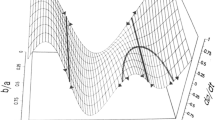Abstract
A wide range of systems appear to perform computation: what common features do they share? I consider three examples, a digital computer, a neural network and an analogue route finding system based on soap-bubbles. The common feature of these systems is that they have autonomous dynamics — their states will change over time without additional external influence. We can take advantage of these dynamics if we understand them well enough to map a problem we want to solve onto them. Programming consists of arranging the starting state of a system so that the effects of the system's dynamics on some of its variables corresponds to the effects of the equations which describe the problem to be solved on their variables. The measured dynamics of a system, and hence the computation it may be performing, depend on the variables of the system we choose to attend to. Although we cannot determine which are the appropriate variables to measure in a system whose computation basis is unknown to us I go on to discuss how grammatical classifications of computational tasks and symbolic machine reconstruction techniques may allow us to rule out some measurements of a system from contributing to computation of particular tasks. Finally I suggest that these arguments and techniques imply that symbolic descriptions of the computation underlying cognition should be stochastic and that symbols in these descriptions may not be atomic but may have contents in alternative descriptions.
Similar content being viewed by others
References
D.H. Ackley, G.E. Hinton, and T.J. Sejnowski (1985), ‘A Learning Algorithm for Boltzmann Machines’,Cognitive Science 9, 147–169.
P. Bak, C. Tang, and K. Wiesenfeld (1987) ‘Self-organized Criticality: An Explanation of 1/f Noise’,Physical Review Letters 59, 381–384.
G. Chaitin (1975), ‘Randomness and Mathematical Proof’,Scientific American 233, 47–52.
N. Chomsky (1963), ‘Formal Properties of Grammars’, in R.D. Luce, R.B. Bush, and E. Galanter, eds.,Handbook of Mathematical Psychology, Volume 2, Wiley.
J.P. Crutchfield and K. Young (1989), Inferring Statistical Complexity.Physical Review Letters 63: 105–108.
J.P. Crutchfield and K. Young (1990), Computation at the Onset of Chaos. In W.H. Zurek, (ed.)Complexity, Entropy and the Physics of Information. (Santa Fe Institute Proceedings Volume VIII). Addison-Wesley.
W.J. Freeman and B.W. van Dijk (1987), ‘Spatial Patterns of Visual Cortical Fast Eeg During Conditioned Reflex in a Rhesus Monkey.’Brain Research 422, 267–276.
F. Grüneis, M. Nakao, Y. Mizutani, M. Yamamoto, M. Meesmann, and T. Musha (1993), Further Study on 1/f Fluctuations Observed in Central Single Neurons During Rem Sleep.Biological Cybernetics 68, 193–198.
W. Heisenberg (1962),Physics and Philosophy. Harper and Row, 1962.
J. Hintikka (1977), ‘Quantifiers in Natural Languages: Some Logical Problems ii.’Linguistics and Philosophy 1, 153–172.
C. Isenberg (1978),The Science of Soap Films and Soap Bubbles. Tieto.
S.A. Kauffmann (1989), ‘Adaptation on Rugged Fitness Landscapes’ In D.L. Stein, editor,Lectures in the Sciences of Complexity, volume 1 of Santa Fe Institute Studies in the Science of Complexity: Lectures Series. Addison-Wesley.
S.A. Kauffmann (1989), ‘Principles of Adaptation in Complex Systems’, in D.L. Stein, ed.,Lectures in the Sciences of Complexity, volume 1 of Santa Fe Institute Studies in the Science of Complexity: Lectures Series. Addison-Wesley.
S.A. Kauffmann (1991) ‘Antichaos and Adaptation’,Scientific American 265, 64–70.
J.A.S. Kelso, S.L. Bressler, S. Buchanan, G.C. DeGuzman, M. Ding, A. Fuchs, and T. Holroyd (1992), ‘A Phase Transition in Human Brain and Behavior’Physics Letters A 169, 134–144.
R.W. Kentridge (1993), ‘Dissipative-structures and Self-organizing Criticality in Neural Networks With Spatially Localised Connections’ In F. Eeckmann and J.M. Bower, (eds.)Computation and Neural Systems., 531–535. Kluwer Academic Publishers.
R.W. Kentridge (1994), ‘Critical Dynamics of Neural Networks With Spatially Localised Connections’ In M. Oaksford and G. Brown, (eds.) Neurodynamics and Psychology. Academic Press.
R.W. Kentridge (in press) Cognition, Chaos and Non-deterministic Symbolic Computation: The Chinese Room Problem Solved?Think.
S. Kirkpatrick, C.D. Jr. Gelatt, and M.P. Vecchi (1983), ‘Optimization Using Simulated Annealing’Science 220, 671–680.
W. Li, N.H. Packard, and C.G. Langton (1990), ‘Transition Phenomena in Cellular Automata Rule Space’Physica D 45, 77–94.
A. Manaster-Ramer and Q. Yu (1993), ‘Linguistic Mechanism, Physical Mechanism and the Secondary Non-r.e.ness of the Physical World’In Workshop on Physics and Computation PhysComp '92. Proceedings of the Workshop on Physics and Computation, October 2–4, 1992, Dallas, Texas., 24–33. IEEE Computer Society Press.
M. Mitchell, P.T. Hraber, and J.P. Crutchfield (1993), ‘Revisiting the Edge of Chaos: Evolving Cellular Automata to Perform Computations’Complex systems, submitted.
N.H. Packard (1988), ‘Adaptation at the Edge of Chaos’ In J.A.S. Kelso, A.J. Mandell, and M.F. Schlesinger, (eds.)Dynamic Patterns in Complex Systems. World Scientific.
T. Winograd (1983),Language as a Cognitive Process. Volume 1: Syntax, Addison Wesley.
M.P. Young, K. Tanaka, and S. Yamane (1992), ‘On Oscillating Neuronal Responses in the Visual Cortex of the Monkey’,Journal of Neurophysiology 67, 1464–1474.
Author information
Authors and Affiliations
Additional information
This research was supported by DRA Fort Halstead, U.K. Contract number 2051/047/RARDE.
Rights and permissions
About this article
Cite this article
Kentridge, R.W. Symbols, neurons, soap-bubbles and the neural computation underlying cognition. Mind Mach 4, 439–449 (1994). https://doi.org/10.1007/BF00974169
Issue Date:
DOI: https://doi.org/10.1007/BF00974169




